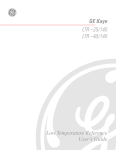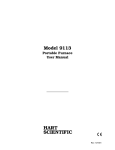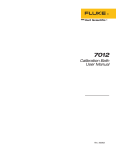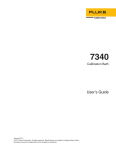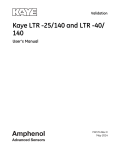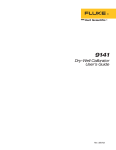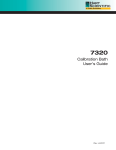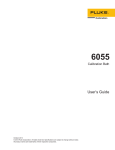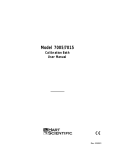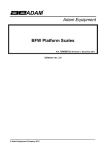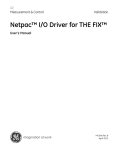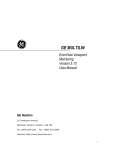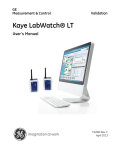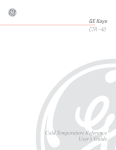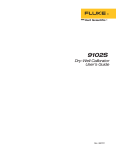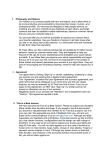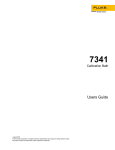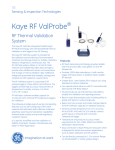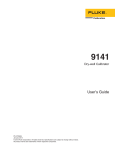Download HTR 400 Users Guide.vp - SiSW >> Science Instruments and Software
Transcript
GE Kaye HTR 400 High Temperature Reference User’s Guide World Headquarters GE Kaye Instruments • 101 Billerica Avenue, Building #7 • North Billerica, MA 01862 • USA tel 978-262-0005, 800-964-5293 (US & Canada) • fax 978-439-8181 • email [email protected] European Headquaters GE Kaye Instruments GmbH • Sinsheimer Strasse 6 • D-75179 Pforzheim • Germany tel +49 (0) 7231 14335 0 • fax +49 (0) 7231 14335 29 email [email protected] www.kayeinstruments.com Subject to change without notice. • Copyright 2002 • Printed in USA Rev. 251301 Table of Contents 1 Before You Start . . . . . . . . . . . . . . . . . . . . . . . . . . . . . . . . 1 1.1 Symbols Used . . . . . . . . . . . . . . . . . . . . . . . . . . . . . . . . . . . . . . . . . . 1 1.2 Safety Information. . . . . . . . . . . . . . . . . . . . . . . . . . . . . . . . . . . . . . . . 2 1.2.1 1.2.2 Warnings Cautions 2 4 1.3 Customer Service Information . . . . . . . . . . . . . . . . . . . . . . . . . . . . . . . . . . 6 2 Introduction . . . . . . . . . . . . . . . . . . . . . . . . . . . . . . . . . . 7 3 Specifications and Environmental Conditions . . . . . . . . . . . . . . . . . 9 3.1 Specifications . . . . . . . . . . . . . . . . . . . . . . . . . . . . . . . . . . . . . . . . . . 9 3.2 Environmental Conditions . . . . . . . . . . . . . . . . . . . . . . . . . . . . . . . . . . . 10 3.3 Hardware Warranty and Assistance . . . . . . . . . . . . . . . . . . . . . . . . . . . . . . 10 3.3.1 3.3.2 3.3.3 3.3.4 3.3.5 3.3.6 3.3.7 Instrument Warranty In-Warranty Repairs After-Warranty Repairs Equipment Maintenance Agreements Customer Support Customer Support Agreement Customer Site Assistance 10 11 11 11 11 12 12 4 Quick Start . . . . . . . . . . . . . . . . . . . . . . . . . . . . . . . . . . 13 4.1 4.2 4.3 4.4 Unpacking . . . . . . . Set-up . . . . . . . . . Power. . . . . . . . . . Setting the Temperature . . . . . . . . . . . . . . . . . . . . . . . . . . . . . . . . . . . . . . . . . . . . . . . . . . . . . . . . . . . . . . . . . . . . . . . . . . . . . . . . . . . . . . . . . . . . . . . . . . . . . . . . . . . . . . . . . . . . . . . . . . . . . . . . . . . . . . . . . . . . . . . . 13 13 13 14 5 Parts and Controls . . . . . . . . . . . . . . . . . . . . . . . . . . . . . . 15 5.1 Rear Panel . . . . . . . . . . . . . . . . . . . . . . . . . . . . . . . . . . . . . . . . . . . 15 5.2 Front Panel . . . . . . . . . . . . . . . . . . . . . . . . . . . . . . . . . . . . . . . . . . . 16 5.3 Constant Temperature Block Assembly . . . . . . . . . . . . . . . . . . . . . . . . . . . . . 17 5.3.1 Constant Temperature Block 17 6 General Operation . . . . . . . . . . . . . . . . . . . . . . . . . . . . . . 19 6.1 Calibrator Set-Up. . . . . . . . . . . . . . . . . . . . . . . . . . . . . . . . . . . . . . . . 19 6.2 Switching Voltage Operation . . . . . . . . . . . . . . . . . . . . . . . . . . . . . . . . . 19 6.3 Setting the Temperature . . . . . . . . . . . . . . . . . . . . . . . . . . . . . . . . . . . . 19 i 6.4 Calibrating Sensors. . . . . . . . . . . . . . . . . . . . . . . . . . . . . . . . . . . . . . . 20 7 Controller Operation . . . . . . . . . . . . . . . . . . . . . . . . . . . . . 23 7.1 Well Temperature. . . . . . . . . . . . . . . . . . . . . . . . . . . . . . . . . . . . . . . . 23 7.2 Reset Cutout . . . . . . . . . . . . . . . . . . . . . . . . . . . . . . . . . . . . . . . . . . 23 7.3 Temperature Set-point . . . . . . . . . . . . . . . . . . . . . . . . . . . . . . . . . . . . . 25 7.3.1 7.3.2 Programmable Set-points (Set-point Memory) Set-point Value 25 26 7.4 Set-point Resistance . . . . . . . . . . . . . . . . . . . . . . . . . . . . . . . . . . . . . . 26 7.5 Ramp and Soak Program Menu . . . . . . . . . . . . . . . . . . . . . . . . . . . . . . . . 27 7.5.1 7.5.2 7.5.3 7.5.4 7.5.5 Number of Program Set-points Set-points Program Soak Time Program Function Mode Program Control 7.6 Secondary Menu . . . . . 7.7 Heating Power . . . . . . 7.8 Proportional Band . . . . 7.9 Cutout . . . . . . . . . . 7.10 Controller Configuration . . . . . . . . . . . . . . . . 27 27 28 28 29 . . . . . . . . . . . . . . . 7.10.1 Probe Parameters 7.10.1.1 R0. . . . . . . . . . . . 7.10.1.2 ALPHA . . . . . . . . . 7.10.1.3 DELTA. . . . . . . . . . 7.10.2 Operating Parameters 7.10.2.1 Temperature Scale Units 7.10.2.2 Cutout Reset Mode . . . 7.10.3 Serial Interface Parameters 7.10.3.1 BAUD Rate . . . . . . . 7.10.3.2 Sample Period . . . . . 7.10.3.3 Duplex Mode . . . . . . 7.10.3.4 Linefeed . . . . . . . . 7.10.4 Calibration Parameters 7.10.4.1 CTO . . . . . . . . . . . 7.10.4.2 CO and CG . . . . . . . 7.10.4.3 SCO . . . . . . . . . . . . . . . . . . . . . . . . . . . . . . . . . . . . . . . . . . . . . . . . . . . . . . . . . . . . . . . . . . . . . . . . . . . . . . . . . . . . . . . . . . . . . . . . . . . . . . . . . . . . . . . . . . . . . . . . . . . . . . . . . . . . . . . . . . . . . . . . . . . . . . . . . . . . 29 30 30 32 33 33 . . . . . . . . . . . . . . . . . . . . . . . . . . . . . . . . . . . . . 33 . . . . . . . . . . . . . . . . . . . . . . . . . . . . . . . . . . . . . 33 . . . . . . . . . . . . . . . . . . . . . . . . . . . . . . . . . . . . . 33 34 . . . . . . . . . . . . . . . . . . . . . . . . . . . . . . . . . . . . . 34 . . . . . . . . . . . . . . . . . . . . . . . . . . . . . . . . . . . . . 34 35 . . . . . . . . . . . . . . . . . . . . . . . . . . . . . . . . . . . . . 35 . . . . . . . . . . . . . . . . . . . . . . . . . . . . . . . . . . . . . 35 . . . . . . . . . . . . . . . . . . . . . . . . . . . . . . . . . . . . . 35 . . . . . . . . . . . . . . . . . . . . . . . . . . . . . . . . . . . . . 36 36 . . . . . . . . . . . . . . . . . . . . . . . . . . . . . . . . . . . . . 37 . . . . . . . . . . . . . . . . . . . . . . . . . . . . . . . . . . . . . 37 . . . . . . . . . . . . . . . . . . . . . . . . . . . . . . . . . . . . . 37 8 Calibration Procedure . . . . . . . . . . . . . . . . . . . . . . . . . . . . 39 8.1 8.2 8.3 8.4 Calibration Points . . . . . . Measuring the Set-point Error Computing R0 and ALPHA . . Calibration Example . . . . . . . . . . . . . . . . . . . . . . . . . . . . . . . . . . . . . . . . . . . . . . . . . . . . . . . . . . . . . . . . . . . . . . . . . . . . . . . . . . . . . . . . . . . . . . . . . . . . . . . . . . . . . . . . . . . . . . . . . . . . . . . . . . . . . . . . . 39 39 40 40 9 Maintenance . . . . . . . . . . . . . . . . . . . . . . . . . . . . . . . . . 43 ii 10 Troubleshooting . . . . . . . . . . . . . . . . . . . . . . . . . . . . . . . 45 10.1 Troubleshooting . . . . . . . . . . . . . . . . . . . . . . . . . . . . . . . . . . . . . . . . 45 10.2 Comments . . . . . . . . . . . . . . . . . . . . . . . . . . . . . . . . . . . . . . . . . . . 46 10.2.1 EMC Directive 10.2.2 Low Voltage Directive (Safety) 46 46 10.3 Wiring Diagram . . . . . . . . . . . . . . . . . . . . . . . . . . . . . . . . . . . . . . . . 47 iii Figures and Tables Table 1 Table 2 Figure 1 Figure 2 Figure 3 Figure 4 Figure 5 Figure 6 Figure 7 iv International Electrical Symbols . . . . . . . . . . . . . . . . . . . . . . . . . . . . . . . . . . 1 Specifications. . . . . . . . . . . . . . . . . . . . . . . . . . . . . . . . . . . . . . . . . . . . 9 HTR 400 Back Panel . . . . . . . . . . . . . . . . . . . . . . . . . . . . . . . . . . . . . . . 15 Front Panel . . . . . . . . . . . . . . . . . . . . . . . . . . . . . . . . . . . . . . . . . . . . 16 Temperature Block . . . . . . . . . . . . . . . . . . . . . . . . . . . . . . . . . . . . . . . . 17 Controller Function Flowchart . . . . . . . . . . . . . . . . . . . . . . . . . . . . . . . . . . 24 Well Temperature Fluctuation at Various Proportional Band Settings . . . . . . . . . . . . . . 31 Calibration Example . . . . . . . . . . . . . . . . . . . . . . . . . . . . . . . . . . . . . . . 41 Wiring Diagram . . . . . . . . . . . . . . . . . . . . . . . . . . . . . . . . . . . . . . . . . 47 1 Before You Start 1 1.1 Before You Start Symbols Used Table 1 lists the symbols used on the instrument or in this manual and the meaning of each symbol. Table 1 International Electrical Symbols Symbol Description AC (Alternating Current) AC-DC Battery Complies with European Union directives DC Double Insulated Electric Shock Fuse PE Ground Hot Surface (Burn Hazard) Read the User’s Manual (Important Information) Off On 1 1 Before You Start Symbol Description Canadian Standards Association CAT II 1.2 OVERVOLTAGE (Installation) CATEGORY II, Pollution Degree 2 per IEC1010-1 refers to the level of Impulse Withstand Voltage protection provided. Equipment of OVERVOLTAGE CATEGORY II is energy-consuming equipment to be supplied from the fixed installation. Examples include household, office, and laboratory appliances. Safety Information Use this instrument only as specified in this manual. Otherwise, the protection provided by the instrument may be impaired. Refer to the safety information in the Warnings and Cautions sections below. The following definitions apply to the terms “Warning” and “Caution”. • “Warning” identifies conditions and actions that may pose hazards to the user. • “Caution” identifies conditions and actions that may damage the instrument being used. 1.2.1 Warnings To avoid possible shock or personal injury, follow the guidelines. GENERAL • This instrument is intended for indoor use only. • DO NOT use this instrument in environments other than those listed in the User’s Guide. • Follow all safety guidelines listed in the user’s manual. • Calibration Equipment should only be used by Trained Personnel. • DO NOT use this instrument for any application other than calibration work. The instrument was designed for temperature calibration. Any other user of the instrument may cause unknown hazards to the user. • DO NOT turn the instrument upside down with the inserts in place; the inserts will fall out. • Completely unattended operation is not recommended for safety reasons. 2 1 Before You Start • Overhead clearance is required. DO NOT place the instrument under a cabinet or other structure. Always leave enough clearance above the instrument to allow for safe and easy insertion and removal of probes. • If the instrument is used in a manner not in accordance with the equipment design, the operation of the dry-well may be impaired or safety hazards may arise. • Inspect the instrument for damage before each use. DO NOT use the instrument if it appears damaged or operates abnormally. • If this equipment is used in a manner not specified by the manufacturer, the protection provided by the equipment may be impaired. • Before initial use, or after transport, or after storage in humid or semi-humid environments, or anytime the dry-well has not been energized for more than 10 days, the instrument needs to be energized for a "dry-out" period of 2 hours before it can be assumed to meet all of the safety requirements of the IEC 1010-1. If the product is wet or has been in a wet environment, take necessary measures to remove moisture prior to applying power such as storage in a low humidity temperature chamber operating at 50°C for 4 hour or more. BURN HAZARD • DO NOT touch the well access surface of the instrument. • The temperature of the well access is the same as the actual display temperature, e.g. if the instrument is set to 400°C and the display reads 400°C, the well is at 400°C. • The top sheet metal of the dry-well may exhibit extreme temperatures for areas close to the well access. • The air over the well can reach temperatures greater that 100°C for high temperature (400°C and higher) dry-wells. Note: Probes and inserts may be hot and should only be inserted and removed from the instrument when the instrument is set at temperatures less than 50°C. Use extreme care when removing hot inserts. • DO NOT turn off the instrument at temperatures higher than 100°C. This could create a hazardous situation. Select a set-point less than 100°C and allow the instrument to cool before turning it off. • DO NOT operate near flammable materials. • Use of this instrument at HIGH TEMPERATURES for extended periods of time requires caution. 3 1 Before You Start • The block vent may be very hot due to the fan blowing across the heater block of the dry-well. • The high temperatures present in dry-wells designed for operation at 300°C and higher may result in fires and severe burns if safety precautions are not observed. • DO NOT turn the instrument upside down with the inserts in place; the inserts will fall out. ELECTRICAL • Always replace the power cord with an approved cord of the correct rating and type. • HIGH VOLTAGE is used in the operation of this equipment. SEVERE INJURY or DEATH may result if personnel fail to observe safety precautions. Before working inside the equipment, turn power off and disconnect power cord. • These guidelines must be followed to ensure that the safety mechanisms in this instrument will operate properly. This instrument must be plugged into a 115 VAC, 60Hz (230 VAC, 50Hz optional), AC only electric outlet. The power cord of the instrument is equipped with a three-pronged grounding plug for your protection against electrical shock hazards. It must be plugged directly into a properly grounded three-prong receptacle. The receptacle must be installed in accordance with local codes and ordinances. Consult a qualified electrician. DO NOT use an extension cord or adapter plug. • If supplied with user accessible fuses, always replace the fuse with one of the same rating, voltage, and type. 1.2.2 Cautions • Component lifetime can be shortened by continuous high temperature operation. • Most probes have handle temperature limits. Be sure that the probe handle temperature limit is not exceeded in the air above the instrument. • DO NOT use fluids to clean out the well. • Never introduce any foreign material into the probe hole of the insert. Fluids, etc. can leak into the instrument causing damage. 4 1 Before You Start • DO NOT change the values of the calibration constants from the factory set values. The correct setting of these parameters is important to the safety and proper operation of the calibrator. • DO NOT slam the probe stems in to the well. This type of action can cause a shock to the sensor and affect the calibration. • The instrument and any thermometer probes used with it are sensitive instruments that can be easily damaged. Always handles these devices with care. DO NOT allow them to be dropped, struck, stressed, or overheated. • The Factory Reset Sequence (see Section 10, Troubleshooting) should be performed only by authorized personnel if no other action is successful in correcting a malfunction. You must have a copy of the most recent Report of Calibration to restore the calibration parameters. • DO NOT operate this instrument in an excessively wet, oily, dusty, or dirty environment. Always keep the well and inserts clean and clear of foreign material. • The instrument is a precision instrument. Although it has been designed for optimum durability and trouble free operation, it must be handled with care. Always carry the instrument in an upright position to prevent the probe sleeves from dropping out. The convenient fold-up handle allows one hand carrying. • If a mains supply power fluctuation occurs, immediately turn off the instrument. Power bumps from brown-outs could damage the instrument. Wait until the power has stabilized before re-energizing the instrument. • Always operate this instrument at room temperature between 41°F and 122°F (5°C to 50°C). Allow sufficient air circulation by leaving at least 10 inches (25.4 cm) of clearance around the instrument. 5 1 Before You Start 1.3 Customer Service Information GE Kaye Instruments can be contacted by writing to: World Headquarters GE Kaye Instruments, Inc. 101 Billerica Avenue, Building 7 North Billerica, MA 01862 tel. +1 (978) 262 0005 fax +1 (978) 439 8181 e-mail [email protected] European Headquarters GE Kaye Instruments GmbH Sinsheimer Strasse 6 D-75179 Pforzheim, Germany tel. +49-(0)-7231-14335-0 fax +49-(0)-7231-14335-29 e-mail [email protected] [email protected] When contacting GE Kaye Instruments Customer Service, please have the following information available: • Model Number • Serial Number • Voltage 6 2 Introduction 2 Introduction The GE Kaye High Temperature Reference provides a stable, portable temperature reference for performing thermocouple and RTD calibration. The HTR 400 operates over the range of 50°C to 400°C (122°F to 752°F). The HTR 400 is most commonly used with GE Kaye’s Intelligent RTD (IRTD) probe and Validator 2000 to make up a complete validation system. The HTR 400 has the ability to rapidly heat, making it an ideal instrument for performing multiple-point calibrations for a variety of processes, such as incubators and steam sterilizers. The HTR 400 calibrator has ten wells. For calibrating thermocouples, there are inserts that go into eight of the wells to reduce stem conduction errors thereby providing maximum accuracy and stability. To calibrate RTD's, there are special inserts available through GE Kaye Instruments. The eight calibration wells are drilled at a 0.354" (9mm) diameter, and with inserts are able to hold up to three GE Kaye Instruments Type T 22 gauge Teflon or Kapton thermocouples per well for a total of 24 sensors. With inserts, a single RTD can fit into each well. The two reference wells are 0.265" (6.7mm) in diameter to accommodate GE Kaye Instrument Intelligent RTD probes. The temperature of the wells is accurately controlled by an internal analog/digital temperature controller. The temperature controller uses a precision platinum RTD as a sensor and controls the well temperature with a solid state relay (triac) driven heater. On the front panel of the instrument is an LED display that continuously shows the current well temperature. The well temperature can be set to any temperature within the specified range by using the four control buttons located on the instrument's front panel. The HTR 400 calibrator's multiple fault protection devices ensure user and instrument safety protection. The Validator 2000 automatically performs the sensor calibration, including programming the set-point temperatures at the HTR 400. If you are using the HTR 400 as a standalone instrument, the temperatures can be manually set to any temperature within the specified range by using the four control buttons located on the front panel. These dry-well calibrators are designed for portability, moderate cost, and ease of operation. With proper use they should provide continued accurate calibration of temperature sensors and devices. The user should be familiar with the safety guidelines and operating procedures of the calibrator as described in this User’s Guide. 7 3 Specifications and Environmental Conditions 3 3.1 Specifications and Environmental Conditions Specifications The following table lists the specifications for this instrument. Accuracy specifications are applicable for a one-year calibration interval. In line with normal prudent metrology practices, A short-cycle interval of six months is recommended for new instruments during the first year. Table 2 Specifications Range 50°C to 400°C (122°F to 752°F) at 25°C (77°F) Accuracy ±0.2°C (0.36°F) to 300°C; ±0.3°C (0.54°F) at 400°C Stability ±0.02°C (0.036°F) to 300°C; ±0.05°C (0.09°F) at 400°C Well to Well Uniformity (calibration wells) Transfer calibration accuracy of thermocouples with inserts to IRTD probe (Excluding reference probe uncertainty) Well Depth ±0.05°C (0.09°F) ±0.1°C from 50°C to 150°C ±0.125°C from 150°C to 400°C 6.1" (155 mm) Heating Time 5 minutes: 25°C to 100°C; 25 minutes: 25°C to 350°C Cooling Time 85 minutes: 350°C to 50°C; 45 minutes: 125°C to 50°C Test Wells Two 6.7 mm (0.265") dia., eight 9 mm (0.354") dia. Standard Calibration Well Inserts Eight removable Accomodates up to three 22 guage thermocouples Resolution Display Size 0.01° LED, °C or °F, user selectable 13.5" H x 7.8" W x 12.5" D (343 x 198 x 317 mm) Weight 30 lb. (13.6 kg) Power 115 VAC (±10%), 10 A, 50/60 Hz, 230 VAC (±10%), 5 A, 50/60 Hz, 700 watts Operating Range Controller 5–50°C (41–122°F) Hybrid analog/digital controller with data retention 9 3 Specifications and Environmental Conditions Safety Fault Protection OVERVOLTAGE (Installation) CATEGORY II, Pollution Degree 2 per IEC1010-1 Sensor burnout protection, over-temperature cutout, and electrical fuses Fuses 3.2 115V - 10A F, 250 V 230V - 5A F, 250 V Environmental Conditions Although these instruments have been designed for optimum durability and trouble-free operation, they must be handled with care. The instrument should not be operated in an excessively dusty or dirty environment. Maintenance and cleaning recommendations can be found in the Maintenance Section of this manual. The instrument operates safely under the following conditions: • temperature range 5 - 50°C (41 - 122°F) • ambient relative humidity 15 - 50% • pressure - 75kPa - 106kPa • mains voltage within ± 10% of nominal • vibrations in the calibration environment should be minimized • altitude less than 2,000 meters • indoor use only 3.3 Hardware Warranty and Assistance 3.3.1 Instrument Warranty GE Kaye Instruments warrants its products against defects in materials and workmanship for a period of 12 months from the date of shipment. GE Kaye Instruments will, at its option, repair or replace products which prove defective during this warranty period provided they are returned to our facility in Billerica, Massachusetts, European warranty returns are sent to Pforzheim, Germany. Repairs necessitated by misuse of this product are not covered by this warranty. No other warranties are expressed or implied, including but not limited to the implied warranties of merchantability and fitness for a particular purpose. Kaye Instruments Inc. is not liable for consequential damages. 10 3 Specifications and Environmental Conditions 3.3.2 In-Warranty Repairs Customers are requested to discuss their problem with a Kaye Service Representative to insure a prompt and accurate assessment of their needs. Frequently, a problem can be resolved via phone or FAX with minimal inconvenience or delay. If necessary, the Customer Service Representative will send replacement parts or authorize the return of the instrument to the factory for repair. Instruments serviced in this manner will be repaired, completely tested, and calibrated prior to shipment. When an instrument is returned to the factory, the customer must prepay the freight charges. Kaye will prepay freight charges for the instrument's return via a comparable shipment method. If Field Service is required under the warranty, the customer is responsible for travel and living expenses incurred by the Field Service Representative. 3.3.3 After-Warranty Repairs Customers are requested to discuss their problem with a Kaye Service Representative to insure a prompt assessment of their needs. Frequently, a customer installed exchange part will solve the problem with minimal inconvenience and expense. Factory repairs can frequently be completed on a fixed price basis. A base service fee plus labor and materials will be charged in lieu of the fixed repair price upon customer request or if extensive repairs are required. Customers are requested to obtain a return authorization number prior to returning any instrument for service. All instruments serviced at the factory will be repaired, updated, calibrated, and completely tested prior to shipment. 3.3.4 Equipment Maintenance Agreements An optional Equipment Maintenance Agreement provides an annual preventive maintenance visit with certified recalibration, plus replacement parts throughout the year. Contact the Customer Service Department at (800) 964-5293 for details and prices. European customers contact the Customer Service Department at +49 (0) 7231 14335 0. 3.3.5 Customer Support Within 90 days of shipment from the factory, installation and initial configuration assistance will be provided by a Customer Service Representative via phone or FAX at no charge. 11 3 Specifications and Environmental Conditions After 90 days from shipment, technical assistance or consultation will be limited to identification and resolution of instrument failures, unless a Customer Support Agreement has been purchased. 3.3.6 Customer Support Agreement An optional Customer Support Agreement provides additional phone or FAX technical assistance for installation or program development. Contact the Customer Service Department for details. 3.3.7 Customer Site Assistance Kaye can provide optional onsite assistance with installation, initial operation, and training of plant personnel. Contact the Customer Service Department for details. 12 4 Quick Start 4 4.1 Quick Start Unpacking Unpack the dry-well carefully and inspect it for any damage that may have occurred during shipment. If there is shipping damage, notify the carrier immediately. Verify that the following components are present: • HTR 400 • Thermocouple Insert, GE Kaye Part number J6520, 8 ea. • Power Cord • User's Guide • Certificate of Calibration • Serial Cable 4.2 Set-up Place the calibrator on a flat surface with at least 10 inches of free space around the instrument. Overhead clearance is required. DO NOT place under a flammable structure or cabinet. Plug the power cord into a grounded mains outlet. Observe that the nominal voltage corresponds to that indicated on the back of the calibrator. Turn on the power to the calibrator by toggling the switch on the power entry module. The fan should begin blowing air through the instrument and the controller display should illuminate after 3 seconds. After a brief self-test, the controller should begin normal operation. If the instrument fails to operate, check the power connection. The display begins to show the well temperature and the well heater starts operating to bring the temperature of the well to the set-point temperature. 4.3 Power Plug the dry-well power cord into a mains outlet of the proper voltage, frequency, and current capability. See Section 3.1, Specifications, for power details. Turn the dry-well on using the rear panel “POWER” switch. The dry-well turns on and begins to heat to the previously programmed temperature set-point. The front panel LED display indicates the actual dry-well temperature. 13 4 Quick Start This instrument is field switchable between 115 VAC and 230 VAC. Refer to Section 6.2, Switching to 230 V Operation, for information on switching the voltage. 4.4 Setting the Temperature When you calibrate thermocouples using the HTR 400 and the Validator 2000, the set-points are defined as part of the calibration procedure and automatically downloaded from the Validator 2000 to the HTR 400. If you are using the HTR 400 as a standalone instrument, Section 7.3 explains in detail how to set the temperature set-point on the calibrator using the front panel keys. The procedure is summarized here. 1. Press “SET” twice to access the set-point value. 2. Press “UP” or “DOWN” to change the set-point value. 3. Press “SET” to program in the new set-point. 4. Press “EXIT” to return to the temperature display. When the set-point temperature is changed, the controller switchs the well heater on or off to raise or lower the temperature. The displayed well temperature gradually changes until it reaches the set-point temperature. The well may require 5 to 60 minutes to reach the set-point depending on the span. Another 5 to 10 minutes is required to settle within 1°C of the set-point and 20 to 30 minutes to stabilize with ±0.02°C of the set-point. Ultimate stability may take 1 hour or more of stabilization time. 14 5 Parts and Controls 5 Parts and Controls The user should become familiar with the dry-well calibrator and its parts. Rear Panel See Figure 1. Power Cord - At the rear of the calibrator is the removable power cord that plugs into a standard 115 VAC (230 VAC optional) grounded socket. Power Switch - The power switch is located on the left corner of the rear panel. Serial Port - This D-9 connector is for interfacing the calibrator to a computer or terminal with serial RS-232 communications. TURN POWER OFF BEFORE CONNECTING CABLES RS-232 HTR 400 A24002H 200V 1000 W LINE VOLTAGE INSTRUCTIONS SWITCH POSITION VOLTS FUSE REQUIRED DN-DN 230VAC UP-UP 115VAC 5A F 10A F 115V 1000W FUSES F U SE F U SE F U SE | POWER F U SE 5.1 50/60 Hz 0 Before opening disconnect mains. Vor Öffnen des Gehäuses Netzstecker ziehen. Avant d’ouvrir l’appereil retirez la fichemâle. Figure 1 HTR 400 Back Panel 15 5 Parts and Controls Fuse Holders - At the rear of the calibrator are two user accessable fuse holders. 5.2 Front Panel See Figure 2 on page 16. Controller Display - The digital display is an important part of the temperature controller because it not only displays set and actual temperatures but also various calibrator functions, settings, and constants. The display shows temperatures in units according to the selected scale °C or °F. Controller Keypad - The four button keypad allows easy setting of the set-point temperature. The control buttons (SET, DOWN, UP, and EXIT) are used to set the calibrator temperature set-point, access and set other operating parameters, and access and set calibration parameters. Setting the control temperature is done directly in degrees of the current scale. It can be set to one-hundredth of a degree Celsius. The functions of the buttons are as follows: SET – Used to display the next parameter in the menu and to set parameters to the displayed value. DOWN – Used to decrement the displayed value of parameters. UP – Used to increment the displayed value. EXIT – Used to exit from a menu. When EXIT is pressed, any changes made to the displayed value are ignored. Control Indicator - The Control Indicator is a two color light emitting diode. This indicator lets the user visually see the ratio of heating to cooling. When the indicator is constant red the well is heating, and when it is constant green HTR 400 102.80C Set Figure 2 Front Panel 16 Down Up Exit 5 Parts and Controls the well is cooling. When the indicator is flashing then the temperature is being held constant. 5.3 Constant Temperature Block Assembly 5.3.1 Constant Temperature Block The block, Figure 3, is made of aluminum and provides a relatively constant and accurate temperature environment in which the sensors that are to be calibrated are inserted. Attached to the block are Peltier thermoelectric modules which heat or cool the block to maintain a constant temperature. A high-quality platinum RTD is imbedded in the block to sense the temperature and provide feedback to the temperature controller. 6.7 mm (0.265") R 9 mm (0.354") 9 mm (0.354") R 6.7 mm (0.265") Figure 3 Temperature Block 17 6 General Operation 6 6.1 General Operation Calibrator Set-Up Place the calibrator on a flat surface with at least 10 inches of free space around the instrument. DO NOT place under a flammable structure or cabinet.Plug the power cord into a grounded mains outlet. Observe that the nominal voltage corresponds to that indicated on the back of the calibrator. Gently insert the thermocouple probe sleeves into the well. Sleeves of various sizes are available from the manufacturer. The well must be clear of any foreign objects, dirt, and grit before the sleeve is inserted. The sleeve is inserted with the two small tong holes positioned upward. Turn on the power to the calibrator by toggling the switch at the rear of the instrument to the “l” (on) position. The fan begins circulating air through the instrument. After a brief self test the controller should begin normal operation showing the well temperature. The block heats or cools until it reaches the programmed set-point. 6.2 Switching Voltage Operation The HTR 400 has the ability to operate at one of two line voltages. Ranges are for both 50 and 60Hz operation. To change the mains voltage on the HTR 400 perform the following steps. 1. With a #6 Hex head screwdriver, remove the two (2) screws on the line voltage cover plate. 2. Set the line voltage as per the following table. Nominal Voltage Line Voltage Left Switch Right Switch 115 115 Up Up 200 200 Down Down 3. 6.3 Replace the line voltage cover plate. Setting the Temperature Section 7.3 explains in detail how to set the temperature set-point on the calibrator using the front panel keys. The procedure is summarized here. (1) Press “SET” twice to access the set-point value. (2) Press “UP” or “DOWN” to change the set-point value. (3) Press “SET” to program in the new set-point. 19 6 General Operation (4) Press “EXIT” to return to the temperature display. When the set-point temperature is changed, the controller switchs the well heater on or off to raise or lower the temperature. The cycle indicator, a two color LED, indicates on (red and heating) or off (green and cooling). The displayed well temperature gradually changes until it reaches the set-point temperature. The well may require 5 to 80 minutes to reach the set-point depending on the span. Another 5 to 10 minutes is required to settle within 1°C of the set-point and 20 to 30 minutes to stabilize with ±0.02°C of the set-point. Ultimate stability may take 1 hour or more of stabilization time. 6.4 Calibrating Sensors Sensor calibration is performed prior to carrying out a validation test to correct raw temperature readings to a traceable temperature measurement standard. Due to the HTR 400's range of temperature and rapid heating and cooling capabilities, the instrument can be used to provide calibrations for a variety of validation processes. To provide maximum accuracy, a two-point calibration should be performed close to the operating temperature of the process. The Validator 2000 automatically downloads the calibration set-points defined in your setup to the HTR 400 and controls the entire sensor calibration procedure. Before you begin the calibration process: • Place the Validator 2000 in a location with stable and even temperature, not exposed to any local heat sources (i.e., close to a sterilizer, an open door causing a draft, etc.). • To provide maximum accuracy during the calibration process, power up the Validator 2000 and let it run for approximately 30 minutes in the operating environment where calibration is to be performed in order for the Validator 2000 to acclimate to the ambient temperature. • Since transient environmental temperature causes thermal measurements to change, Kaye specifies that the Validator system be allowed to stabilize for at least 30 minutes for every 10°C change in temperature. For example, if you move the Validator 2000 from a 25°C environment to a 40°C degree environment, it should be allowed to run for 45 minutes before use • Place the thermocouples and IRTD into the HTR 400 making sure to use the well inserts for the thermocouples. The HTR 400 provides the stable temperature required for sensor calibration. The IRTD, a self-contained precision measurement standard that provides data directly to the Validator 2000, accurately measures the temperature of the HTR 400 The IRTD provides a traceable standard that is used to correct the temperature readings of your thermocouples. 20 6 General Operation For more detailed information on the hardware connections and the sensor calibration process, refer to the Validator 2000 User’s Guide. 21 7 Controller Operation 7 Controller Operation This chapter discusses in detail how to operate the dry-well temperature controller using the front panel. Using the front panel key-switches and LED display the user may monitor the well temperature, set the temperature set-point in degrees C or F, monitor the heater output power, adjust the controller proportional band, set the cutout set-point, and program the probe calibration parameters, operating parameters, serial interface configuration, and controller calibration parameters. Operation of the functions are summarized in Figure 4 on page 24. In the following discussion a solid box around the word SET, UP, EXIT or DOWN indicates the panel button while the dotted box indicates the display reading. Explanation of the button or display reading are to the right of each button or display value. 7.1 Well Temperature The digital LED display on the front panel allows direct viewing of the actual well temperature. This temperature value is what is normally shown on the display. The units, C or F, of the temperature value are displayed at the right. For example, 20.00 C Well temperature in degrees Celsius The temperature display function may be accessed from other functions by pressing the “EXIT” button. 7.2 Reset Cutout The cutout has two modes, automatic reset and manual reset (see Section 7.10.2.2) and determines how the cutout resets allowing the instrument to heat up again. When in automatic mode, the cutout resets itself as soon as the temperature is lowered below the cutout set-point. With manual reset mode, the cutout must be reset by the operator after the temperature falls below the set-point. If the over-temperature cutout has been triggered, the temperature display alternately flashes the temperature and cutout. Cut-out Indicates cutout condition The message continues to flash until the temperature is reduced and the cutout is reset. 23 7 Controller Operation Display Temperature SET + DOWN SET + Display Set-point Resolution UP EXIT SET SET Reset Cutout EXIT Number of Set-points SET Cutout Active SET Select Set-point EXIT Adjust Set-point SET SET EXIT + SET Soak Time EXIT SET SET Display Power EXIT Program Function Mode SET EXIT EXIT Set Proportional Band SET/EXIT SET Set Cutout Temp. EXIT SET Configuration Menu EXIT SET EXIT EXIT UP Probe Menu EXIT UP Operating Parameters Menu DOWN EXIT UP Serial Interface Menu Calibration Menu DOWN SET SET SET SET R0 Units Sample Period CTO EXIT EXIT SET EXIT SET Adj. R0 Adjust Units SET/EXIT SET/EXIT SET/EXIT ALPHA Cutout Reset Mode Duplex Mode SET EXIT SET EXIT SET Adj. ALPHA Adj. Duplex Mode SET/EXIT SET/EXIT SET/EXIT Linefeed DELTA EXIT SET Adj. DELTA Adjust Linefeed SET/EXIT SET/EXIT X5 EXIT Adjust CTO EXIT Adj. Cutout Reset Mode SET SET Adj. Sample Period EXIT DO NOT CHANGE THESE VALUES. SEE MANUAL SET DO NOT CHANGE THESE VALUES. SEE MANUAL DOWN SET/EXIT C0 SET EXIT Adjust C0 SET/EXIT CG EXIT SET Adjust CG SET/EXIT SCO SET EXIT Adjust SCO SET/EXIT Figure 4 Controller Function Flowchart Select Set-point SECONDARY FUNCTIONS Adjust Set-point EXIT 24 Program Menu Program Control 7 Controller Operation When the cutout is active and the cutout mode is set to manual (“reset”) the display flashes “Cut-out” until the user resets the cutout. To access the reset cutout function press the “SET” button. Access cutout reset function S The display indicates the reset function. rESEt ? Cutout reset function Press “SET” once more to reset the cutout. Reset cutout S This switches the display to the set temperature function. To return to displaying the temperature press the “EXIT” button. If the cutout is still in the over-temperature fault condition, the display continues to flash “Cut-out”. The well temperature must drop a few degrees below the cutout set-point before the cutout can be reset. 7.3 Temperature Set-point The temperature set-point can be set to any value within the range and with resolution as given in the specifications. Be careful not to exceed the safe upper temperature limit of any device inserted into the well. The safety cutout must be adjusted to prevent this occurrence. Setting the temperature involves two steps: (1) selecting the set-point memory and (2) adjusting the set-point value. 7.3.1 Programmable Set-points (Set-point Memory) The controller stores 8 set-point temperatures in memory. The set-points can be quickly recalled to conveniently set the calibrator to a previously programmed temperature set-point. To set the temperature, select the set-point memory and then adjust the set-point value. This function is accessed from the temperature display function by pressing “SET”. The number of the set-point memory currently being used is shown at the left on the display followed by the current set-point value. 20.00 C S Well temperature in degrees Celsius Access set-point memory 25 7 Controller Operation 1. 20.0 Set-point memory 1, 20.0°C currently used To change the set-point memory, press “UP” or “DOWN”. 3. 400 C New set-point memory 3, 400°C Press “SET” to accept the new selection and access the set-point value. S 7.3.2 Accept selected set-point memory Set-point Value The set-point value may be adjusted after selecting the set-point memory and pressing “SET”. The set-point value is displayed with the units, C or F, at the left. C 400 C Set-point 3 value in °C If the set-point value does not need to be changed, press “EXIT” to resume displaying the well temperature. Press “UP” or “DOWN” to adjust the set-point value. C 398.00 New set-point value When the desired set-point value is reached, press “SET” to accept the new value and access the temperature scale units selection. If “EXIT” is pressed, then any changes made to the set-point are ignored. S 7.4 Accept new set-point value Set-point Resistance The set-point resistance is the resistance the instrument is trying to make the control sensor achieve and is calculated in the firmware using the set-point temperature. This value is not directly adjustable but is recalculated when the set-point temperature is changed. The set-point resistance is used to perform a calibration adjustment using the Callendar-Van Dusen R versus T curve fit (see Section 8, Calibration Procedure). The instrument must be at temperature and stable prior to taking the set-point resistance reading. To display the Set-point Resistance, press “SET” and “DOWN” simultaneously when the temperature is displayed. When the “SET” and “DOWN” buttons are released the temperature is again displayed. 26 7 Controller Operation 7.5 Ramp and Soak Program Menu The ramp and soak program feature allows the user to program a number of set-points and have the dry-well automatically cycle between the temperatures, holding at each for a determined length of time. The user can select one of four different cycle functions. The program parameter menu is accessed by pressing “SET” and then “UP”. 20.00 C S+U ProG Well temperature Access program menu Program menu Press “SET” to enter the program menu S 7.5.1 Enter program menu Number of Program Set-points The first parameter in the program menu is the number of set-points to cycle through. Up to 8 set-points can be used in a ramp and soak program. Pn=8 Number of program set-points Use the “UP” or “DOWN” buttons to change the number from 2 to 8. Pn=3 New number of program set-points Press “SET” to continue. Pressing “EXIT” causes any changes made to the parameter to be ignored. S 7.5.2 Save new setting Set-points The next parameters are the program set-points. 1 25.0 First set-point Use the “UP” or “DOWN” buttons to select any of the 8 set-points. 3 100.0 Third set-point 27 7 Controller Operation Press “SET” to change the set-point. C 100.00 Set-point value Use “UP” and “DOWN” to change the set-point value. C 130.50 New set-point value Press “SET” to save the new set-point value. The other set-points can also be set in the same manner. Once the set-points are programmed as desired press “EXIT” to continue. E 7.5.3 Continue to next menu function Program Soak Time The next parameter in the program menu is the soak time. This is the time, in minutes, that each of the program set-points is maintained after settling before proceeding to the next set-point. The duration is counted from the time the temperature settles to within a specified stability. Pt=15 Soak time in minutes Use the “UP” or “DOWN” buttons to change the time. Pt=5 New soak time Press “SET” to continue. S 7.5.4 Save new setting Program Function Mode The next parameter is the program function or cycle mode. There are four possible modes. They determine whether the program scans up (from set-point 1 to n) only or both up and down (from set-point 1 to n and back from set-point n to 1), and also whether the program stops after one cycle or repeat the cycle indefinitely. The table below shows the action of each of the four program mode settings. 28 7 Controller Operation Function Action 1 up-stop 2 up-down-stop 3 up-repeat 4 up-down-repeat Pf=1 Program mode Use the “UP” or “DOWN” buttons to change the mode. Pf=4 New mode Press “SET” to continue. S 7.5.5 Save new setting Program Control The final parameter in the program menu is the control parameter. The control options are to start the program from the beginning, continue the program from where it was when it was stopped, or stop the program. Pr=OFF Program presently off Use the “UP” or “DOWN” buttons to change the status. Pr=StArt Start cycle from beginning Press “SET” to activate the new program control command and return to the temperature display. S 7.6 Activate new command. Secondary Menu Functions which are used less often are accessed within the secondary menu. The secondary menu is accessed by pressing “SET” and “EXIT” simultaneously and then releasing. The first function in the secondary menu is the heater power display. 29 7 Controller Operation 7.7 Heating Power The temperature controller controls the temperature of the well by heating or cooling the well with the thermoelectric modules. The amount of heating or cooling power depends on the temperature set-point of the well. This heating (or cooling) power value may be estimated by watching the red/green control indicator light or read directly from the digital display. By knowing the amount of heating the user can tell if the calibrator is heating up to the set-point, cooling down, or controlling at a constant temperature. Monitoring the percent heater power allows the user to determine the stability of the well temperature. With good control stability the percent heating power should not fluctuate more than ±1% within one minute. The heater power display is accessed in the secondary menu. Press “SET” and “EXIT” simultaneously and release. The heater power is displayed as a percentage of full power. 20.00 C S+E 12 Pct Well temperature Access heater power in secondary menu Heater power in percent To exit out of the secondary menu press “EXIT”. To continue on to the proportional band setting function press “SET”. 7.8 Proportional Band In a proportional controller such as this, the heater output power is proportional to the well temperature over a limited range of temperatures around the set-point. This range of temperature is called the proportional band. At the bottom of the proportional band the heating is 100%. At the top of the proportional band the cooling is 100%. Thus as the temperature rises the heater power is reduced, which consequently tends to lower the temperature back down. In this way the temperature is maintained at a fairly constant temperature. The temperature stability of the well and response time depend on the width of the proportional band (see Figure 5). If the band is too wide, the well temperature deviates excessively from the set-point due to varying external conditions. This is because the power output changes very little with temperature and the controller cannot respond very well to changing conditions or noise in the system. If the proportional band is too narrow, the temperature may swing back 30 7 Controller Operation and forth because the controller overreacts to temperature variations. For best control stability, the proportional band must be set for the optimum width. Proportional Band too Narrow Proportional Band too Wide Optimum Proportional Band Figure 5 Well Temperature Fluctuation at Various Proportional Band Settings The proportional band width is set at the factory and recorded on the Report of Calibration. The proportional band width may be altered by the user if he desires to optimize the control characteristics for a particular application. The proportional band width is easily adjusted from the front panel. The width may be set to discrete values in degrees C or F depending on the selected units. The proportional band adjustment is accessed within the secondary menu. Press “SET” and “EXIT” to enter the secondary menu and show the heater power. Then press “SET” to access the proportional band. S+E 12 Pct S Access heater power in secondary menu Heater power in percent Access proportional band Pb= 5.23C Proportional band setting To change the proportional band press “UP” or “DOWN”. Pb=3.50C New proportional band setting To accept the new setting and access the cutout set-point, press “SET”. Pressing “EXIT” exits the secondary menu ignoring any changes just made to the proportional band value. 31 7 Controller Operation S 7.9 Accept the new proportional band setting Cutout As a protection against software or hardware fault or user error, the calibrator is equipped with an adjustable cutout device that shuts off power to the heater if the well temperature exceeds a set value. This protects the instrument and probes from excessive temperatures. The cutout temperature is programmable by the operator from the front panel of the controller. If the cutout is activated because of excessive well temperature then power to the heater is shut off and the instrument cools. The well cools until it reaches a few degrees below the cutout set-point temperature. At this point the action of the cutout is determined by the setting of the cutout mode parameter. The cutout has two modes — automatic reset or manual reset. If the mode is set to automatic, the cutout automatically resets itself when the temperature falls below the reset temperature allowing the well to heat up again. If the mode is set to manual, the heater remains disabled until the user manually resets the cutout. The cutout set-point may be accessed within the secondary menu. Press “SET” and “EXIT” to enter the secondary menu and show the heater power. Then press “SET” twice to access the cutout set-point. S+E 12 Pct S Heater power in percent Access proportional band Pb= 5.23C S Access heater power in secondary menu Proportional band setting Access cutout set-point CO= 150C Cutout set-point To change the cutout set-point press “UP” or “DOWN”. CO= 70C New cutout set-point To accept the new cutout set-point press “SET”. S 32 Accept cutout set-point 7 Controller Operation The next function is the configuration menu. Press “EXIT” to resume displaying the well temperature. 7.10 Controller Configuration The controller has a number of configuration and operating options and calibration parameters that are programmable via the front panel. These are accessed from the secondary menu after the cutout set-point function by pressing “SET”. There are 4 sets of configuration parameters—probe parameters, operating parameters, serial interface parameters, and controller calibration parameters. The menus are selected using the “UP” and “DOWN” keys and then pressing “SET”. 7.10.1 Probe Parameters The probe parameter menu is indicated by, PrObE Probe parameters menu Press “SET” to enter the menu. The probe parameters menu contains the parameters, R0, ALPHA, and DELTA that characterize the resistance-temperature relationship of the platinum control probe. These parameters may be adjusted to improve the accuracy of the calibrator. This procedure is explained in detail in Section 8. The probe parameters are accessed by pressing “SET” after the name of the parameter is displayed. The value of the parameter may be changed using the “UP” and “DOWN” buttons. After the desired value is reached press “SET” to set the parameter to the new value. Pressing “EXIT” causes the parameter to be skipped ignoring any changes that may have been made. 7.10.1.1 R0 This probe parameter refers to the resistance of the control probe at 0°C. The value of this parameter is set at the factory for best instrument accuracy. 7.10.1.2 ALPHA This probe parameter refers to the average sensitivity of the probe between 0 and 100°C. The value of this parameter is set at the factory for best instrument accuracy. 7.10.1.3 DELTA This parameter relates to the second order nonlinearity of the sensor. The value is set at the factory for best instrument accuracy. 33 7 Controller Operation 7.10.2 Operating Parameters The operating parameters menu is indicated by, PAr Operating parameters menu Press “UP” to enter the menu. The operating parameters menu contains the units scale selection set and cutout reset mode setting. 7.10.2.1 Temperature Scale Units The temperature scale units of the controller may be set by the user to degrees Celsius (°C) or Fahrenheit (°F). The units are used in displaying the well temperature, set-point, proportional band, and cutout set-point. The temperature scale units selection is the first function in the operating parameters menu. Un= C Scale units currently selected Press “UP” or “DOWN” to change the units. Un= F New units selected Press “SET” to accept the new selection and resume displaying the well temperature. 7.10.2.2 Cutout Reset Mode The cutout reset mode determines whether the cutout resets automatically when the well temperature drops to a safe value or must be manually reset by the operator. The parameter is indicated by, CtorSt Cutout reset mode parameter Press “SET” to access the parameter setting. Normally the cutout is set for automatic mode. Cto=Auto Cutout set for automatic reset To change to manual reset mode, press “DOWN” and then “SET”. Cto=rSt 34 Cutout set for manual reset 7 Controller Operation 7.10.3 Serial Interface Parameters The serial RS-232 interface parameters menu is indicated by, SErIAL Serial RS-232 interface parameters menu The serial interface parameters menu contains parameters which determine the operation of the serial interface. These controls only apply to instruments fitted with the serial interface. The parameters in the menu are — BAUD rate, sample period, duplex mode, and linefeed. 7.10.3.1 BAUD Rate The BAUD rate is set at 2400 and is not adjustable. The BAUD rate of 2400 is required to communicate with the Validator 2000. 7.10.3.2 Sample Period The sample period is the time period in seconds between temperature measurements transmitted from the serial interface. For example, if the sample rate is set to 5, the instrument transmits the current measurement over the serial interface approximately every five seconds. The automatic sampling is disabled with a sample period of 0. The sample period is indicated by, SAnPLE Serial sample period parameter Press “SET” to choose to set the sample period. The current sample period value is displayed. SA= 1 Current sample period (seconds) Adjust the value with “UP” or “DOWN” and then use “SET” to set the sample rate to the displayed value. SA= 60 7.10.3.3 New sample period Duplex Mode The next parameter is the duplex mode. The duplex mode may be set to full duplex or half duplex. With full duplex any commands received by the calibrator via the serial interface are immediately echoed or transmitted back to the device of origin. With half duplex the commands are executed but not echoed. The duplex mode parameter is indicated by, dUPL Serial duplex mode parameter Press “SET” to access the mode setting. 35 7 Controller Operation dUP=FULL Current duplex mode setting The mode may be changed using “UP” or “DOWN” and pressing “SET”. dUP=HALF 7.10.3.4 New duplex mode setting Linefeed The final parameter in the serial interface menu is the linefeed mode. This parameter enables (on) or disables (off) transmission of a linefeed character (LF, ASCII 10) after transmission of any carriage-return. The linefeed parameter is indicated by, LF Serial linefeed parameter Press “SET” to access the linefeed parameter. LF= On Current linefeed setting The mode may be changed using “UP” or “DOWN” and pressing “SET”. LF= OFF 7.10.4 New linefeed setting Calibration Parameters The user has access to a number of the instrument calibration constants namely CTO, C0, and CG. These values are set at the factory and must not be altered. The correct values are important to the accuracy and proper and safe operation of the calibrator. Access to these parameters is available to the user only so that in the event that the controller’s memory fails the user may restore these values to the factory settings. The user should have a list of these constants and their settings with the manual. Caution: DO NOT change the values of the calibration constants from the factory set values. The correct setting of these parameters is important to the safety and proper operation of the calibrator. The calibration parameters menu is indicated by, CAL Calibration parameters menu Press “SET” five times to enter the menu. 36 7 Controller Operation 7.10.4.1 CTO Parameter CTO sets the calibration of the over-temperature cutout. This is not adjustable by software but is adjusted with an internal potentiometer. This parameter should read between 150 and 170. 7.10.4.2 CO and CG These parameters calibrate the accuracy of the temperature set-point. These are programmed at the factory when the instrument is calibrated. Do not alter the value of these parameters. If the user desires to calibrate the instrument for improved accuracy, calibrate R0 and ALPHA according to the procedure given in Section 8. 7.10.4.3 SCO This parameter is used at the factory for testing purposes and should not be altered by the user. 37 8 Calibration Procedure 8 Calibration Procedure Sometimes the user may want to calibrate the dry-well to improve the temperature set-point accuracy. Calibration is done by adjusting the controller probe calibration constants R0 and ALPHA so that the temperature of the dry-well as measured with a standard thermometer agrees more closely with the set-point. The thermometer used must be able to measure the well temperature with higher accuracy than the desired accuracy of the dry-well. By using a good thermometer and carefully following this procedure, the calibrator can be calibrated to an accuracy of better than 0.5°C over a range of 400 degrees. 8.1 Calibration Points In calibrating the dry-well, R0 and ALPHA are adjusted to minimize the set-point error at each of two different dry-well temperatures. Any two reasonably separated temperatures may be used for the calibration. Improved results can be obtained for shorter ranges when using temperatures that are just within the most useful operating range of the dry-well. The farther apart the calibration temperatures, the larger the calibrated temperature range. However, the calibration error will be greater over that range. For instance, if 150°C and 400°C are chosen as the calibration temperatures, the calibrator may achieve an accuracy of ±0.2°C over the range 100 to 400°C. Choosing 200°C and 300°C may allow the calibrator to have a better accuracy of maybe ±0.05°C over the narrower range of 175 to 325°C but outside that range the accuracy may be only ±0.4°C. 8.2 Measuring the Set-point Error The first step in the calibration procedure is to measure the temperature errors (including sign) at the two calibration temperatures. First set the calibrator to the lower set-point, tL. Wait for the well to reach the set-point and allow 30 to 60 minutes to stabilize at that temperature. Check the stability with the thermometer. When both the well and the thermometer have stabilized, measure the temperature with the thermometer and compute the temperature error errL, which is the actual well temperature minus the set-point temperature. For example, if the calibrator is set to a lower set-point of tL=200°C and reaches a measured temperature of 199.7°C, the error is –0.3°C. Next, set the calibrator for the upper set-point, tH, and after stabilizing measure the well temperature and compute the error, errH. For example, if the calibrator was set to 400°C and the thermometer measured 400.1°C, the error is +0.1°C. 39 8 Calibration Procedure 8.3 Computing R0 and ALPHA Before computing the new values for R0 and ALPHA, the current values must be known. The values may be found by either accessing the probe calibration menu from the controller panel or by inquiring through the serial interface. The user should keep a record of these values in case they may need to be restored in the future. The new values R0′ and ALPHA′ are computed by entering the old values for R0 and ALPHA, the calibration temperature set-points tL and tH, and the temperature errors errL and errH into the following equations, err t − errL tH ALPHA + 1 R 0 R0 ′ = H L t − t H L (1 + ALPHA tH )errL − (1 + ALPHA tL )errH ALPHA ′ = + 1 ALPHA t − t H L If for example R0 and ALPHA were previously set for 100.2695 and 0.0038319 respectively and the data for tL, tH, errL, and errH were as given above then the new values R0′ and ALPHA′ would be computed as 100.193 and 0.0038272 respectively. Program the new values R0 and ALPHA into the controller. Check the calibration by setting the temperature to tL and tH and measuring the errors again. If desired the calibration procedure may be repeated to further improve the accuracy. 8.4 Calibration Example The calibrator is to be used between 125 and 325°C and it is desired to calibrate the calibrator as accurately as possible for operation within this range. The current values for R0 and ALPHA are 100.000 and 0.0038500 respectively. The calibration points are chosen to be 150.00 and 300.00°C. The measured well temperatures are 149.943 and 299.814°C respectively. Refer to Figure 6 for applying equations to the example data and computing the new probe constants. 40 8 Calibration Procedure R0 = 100.000 ALPHA = 0.0038500 tL = 150.00°C measured t = 149.943°C tH = 300.00°C measured t = 299.814°C Compute errors, errL = 149.943 - 150.00°C = -0.057°C errH = 299.814 - 300.00°C = -0.186°C Compute R0 , R0 ′ = (−0.186 ) × 150.0 − (−0.057 ) × 300.0 0.00385 + 1 100.000 = 99.9723 300.0 − 150.0 Compute ALPHA , ALPHA′ = (1 + 0.00385 × 300.0 )(−0.057 ) − (1 + 0.00385 × 150.0 )(−0.186 ) + 1 0.00385 = 0.0038544 300.0 − 150.0 Figure 6 Calibration Example 41 9 Maintenance 9 Maintenance • The calibration instrument has been designed with the utmost care. Ease of operation and simplicity of maintenance have been a central theme in the product development. Therefore, with proper care the instrument should require very little maintenance. Avoid operating the instrument in an oily, wet, dirty, or dusty environment. • If the outside of the instrument becomes soiled, it may be wiped clean with a damp cloth and mild detergent. Do not use harsh chemicals on the surface which may damage the paint. • It is important to keep the well of the calibrator clean and clear of any foreign matter. DO NOT use fluid to clean out the well. • Use a commercially available plastic or felt brush, of appropriate diameter for a tight fit without any fluid, to clean the well. Complete the cleaning process by using cotton swabs and air to remove any debris. • Inserts should be cleaned periodically. For cold dry-wells operating below 0°C, clean the inserts after operating the instrument at or below 0°C. Use emery cloth or other similar material to clean the outside of the inserts. Ensure that the inserts are wiped clean of any debris loosened in the buffing process. Periodic cleaning of the outside of the inserts ensures easy insertion and removal of the inserts from the well. • The dry-well calibrator should be handled with care. Avoid knocking or dropping the calibrator. • For dry-wells with removable probe sleeves, the sleeves can become covered with dust and carbon material. If the buildup becomes too thick, it could cause the sleeves to become jammed in the wells. Avoid this build up by periodically buffing the sleeves clean. • If a sleeve should be dropped, examine the sleeve for deformities before inserting it in the well. If there is any chance of jamming the sleeve in the well, file or grind off the protuberance. • DO NOT slam the probe stems into the well. This type of action can cause a shock to the sensor. • If a hazardous material is spilt on or inside the equipment, the user is responsible for taking the appropriate decontamination steps as outlined by the national safety council with respect to the material. • If the mains supply cord becomes damaged, replace it with a cord with the appropriate gauge wire for the current of the instrument. If there are any questions, call Customer Service for more information. 43 9 Maintenance • Before using any cleaning or decontamination method except those recommended by GE Kaye Instruments, users should check with GE Kaye Instruments Customer Service to be sure that the proposed method does not damage the equipment. • If the instrument is used in a manner not in accordance with the equipment design, the operation of the dry-well may be impaired or safety hazards may arise. • The over-temperature cutout should be checked every 6 months to see that it is working properly. In order to check the user selected cut-out, follow the controller directions (Section 7.9) for setting the cut-out. Both the manual and the auto reset option of the cut-out should be checked. Set the instrument temperature higher than the cut-out. Check to see if the display flashes cut-out and the temperature is decreasing. 44 10 Troubleshooting 10 Troubleshooting 10.1 Troubleshooting In the event that the dry-well appears to function abnormally, this section may help to find and solve the problem. Several possible problem conditions are described along with likely causes and solutions. If a problem arises, please read this section carefully and attempt to understand and solve the problem. If the dry-well seems faulty or the problem cannot otherwise be solved, contact GE Kaye Instruments Customer Service for assistance (1-800-964-KAYE), or in Europe +49 (0) 7231 14335 0. Be sure to have the instrument model number, serial number, and voltage available. Problem Possible Causes and Solutions Incorrect temperature reading Incorrect R0, ALPHA, and DELTA parameters. Find the values for R0, ALPHA, DELTA, CO, and CG on the Certificate of Calibration that was shipped with the instrument (or from subsequent calibrations of the instrument). Reprogram the parameters into the instrument memory (see Section 7.10.1, Probe Parameters). Allow the instrument to stabilize and verify the accuracy of the temperature reading. Controller locked up. The controller may have locked up due to a power surge or other aberration. Initialize the system by performing the Factory Reset Sequence. Factory Reset Sequence. Hold the “SET” and “EXIT” buttons down at the same time while powering up the instrument. After the instrument displays -init-, release the buttons. The display shows -init-, the instrument model number and the firmware version. After performing the Factory Reset Sequence, all of the configuration parameters are reset to their default values. Reprogram R0, ALPHA, DELTA, CO, and CG parameters into the instrument memory (see Section 7.10.4, Calibration Parameters) and any other applicable configuration parameters. These numbers can be found on the Certificate of Calibration that was shipped with the instrument. Allow the instrument to stabilize and verify the accuracy of the temperature reading. Blank display after mains Blown fuse. A fuse may have blown due to a power surge or failure of a compopower applied nent. Replace the fuse once. If the fuse blows a second time, it is likely caused by the failure of a component. Always replace the fuse with one of the same rating, voltage, and type. Never replace the fuse with one of a higher current rating. The display shows "-273°C" or "-459°F" Sensor is disconnected or shorted. Please contact GE Kaye Instruments Customer Service for further instructions. The display shows "cut-out" Software cut-out is set to low. Check the cutout setting in the Set-point menu. The red LED on the display Power problem. Check that there is power to the instrument. is blank The instrument heats slowly Incorrect Scan and Scan Rate settings. The scan may be on with the scan rate set low. Check these settings. 45 10 Troubleshooting Problem Possible Causes and Solutions An "o" or "c" is displayed at the left of the display External switch is open. The displayed temperature is frozen and keeping the set-point from scanning because the external switch is open. Turn the Switch Test off by pressing the "DOWN" button on the front panel. 10.2 Comments 10.2.1 EMC Directive GE Kaye Instruments’ equipment has been tested to meet the European Electromagnetic Compatibility Directive (EMC Directive, 89/336/EEC). The Declaration of Conformity for your instrument lists the specific standards to which the instrument was tested. 10.2.2 Low Voltage Directive (Safety) In order to comply with the European Low Voltage Directive (73/23/EEC), GE Kaye Instruments’ equipment has been designed to meet the IEC 1010-1 (EN 61010-1) and the IEC 1010-2-010 (EN 61010-2-010) standards. 46 10 Troubleshooting Wiring Diagram Thursday, April 25, 2002 16:55:28 10.3 Figure 7 Wiring Diagram 47
















































